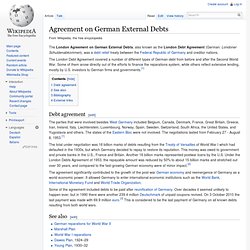

In today's debt crisis, Germany is the US of 1931. A country faces an economic and political abyss: the government is on the brink of bankruptcy and pursues fierce austerity policies; public employees take huge pay cuts and taxes are drastically increased; the economy slumps and unemployment rates explode; people fight each other on the street while banks collapse and international capital flees the country.

Greece in 2011? No, Germany in 1931. The government's head is not Lucas Papademos, but Heinrich Brüning. The "hunger-chancellor" cuts government spending by decree, ignoring parliament while GDP falls without limit. Two years later Hitler will be in power, eight years later the second world war will begin. Like in today's crisis countries, Germany's key problem in 1931 was foreign debts.
The bubble burst when US financial markets collapsed in 1929. To earn dollars Germany had to turn its huge current account deficit into a surplus. But there were not enough dollars available on world markets. Today Germany plays the US role. De cómo los griegos perdonaron a los alemanes su deuda. Londres, 1953: Alemania negocia con 22 países.

La delegación germana ruega a sus socios la condonación de su deuda. Además de las obligaciones contraídas por las ayudas del Plan Marshall, tenía préstamos para pagar reparaciones que aún debía de la Primera Guerra Mundial. La petición es escuchada. Los 22 países –Grecia entre ellos- perdonan a los alemanes la mitad de lo que deben. “Para la joven Alemania, aquel gesto supuso una ayuda enorme”, dice Jürgen Kaiser, coordinador de la iniciativa Año para la Condonación de Deuda (Erlassjahr.de): “El interés de su deuda de aquel entonces es comparable con el que hoy tienen que pagar países en desarrollo e incluso la propia Grecia.”
Londres como ejemplo: protocolo para países con sobreendeudamiento El euro: una moneda con ventajas, pero también con obligaciones. La economía alemana creció con fuerza durante aquel año. TME 167 - El acuerdo de Londres de 1953. El acuerdo de Londres de 1953 El Acuerdo de Londres de 1953 ofrece un ejemplo de alivio de la deuda externa, la vinculación del pago al desarrollo económico y las capacidades exportadoras.

El convenio fue promovido por Estados Unidos, Francia, Reino Unido y otras naciones, todas las cuales parecen haberlo olvidado en estos días. Por Friedel Hütz-Adams A primera vista, podría causar cierta sorpresa el alivio de la deuda alcanzado mediante el Acuerdo de Londres. Al renunciar a la mayoría de sus pretensiones en contra de la República Federal de Alemania, los poderes victoriosos de la Segunda Guerra Mundial ayudaron a un país que, apenas unos pocos años atrás, había atacado y destruido parcialmente sus propios territorios. La dimensión de las deudas en 1952 Después de la Segunda Guerra Mundial, una parte de las deudas alemanas contraídas en la preguerra permanecía todavía sin ser cancelada.
Estados Unidos era la potencia que impulsaba tácitamente las negociaciones. Agreement on German External Debts. The London Agreement on German External Debts, also known as the London Debt Agreement (German: Londoner Schuldenabkommen), was a debt relief treaty between the Federal Republic of Germany and creditor nations.

The London Debt Agreement covered a number of different types of German debt from before and after the Second World War. Some of them arose directly out of the efforts to finance the reparations system, while others reflect extensive lending, mostly by U.S. investors to German firms and governments.[1] Debt agreement[edit] The parties that were involved besides West Germany included Belgium, Canada, Denmark, France, Great Britain, Greece, Iran, Ireland, Italy, Liechtenstein, Luxembourg, Norway, Spain, Sweden, Switzerland, South Africa, the United States, and Yugoslavia and others.
The states of the Eastern Bloc were not involved. The agreement significantly contributed to the growth of the post-war German economy and reemergence of Germany as a world economic power. See also[edit] The Marshall Plan and the Debt Agreement on German debt. {*style:<b>The United States cancelled the debts of some of its allies.

The most obvious instance of this kind was the way the German debt was largely cancelled by the 1953 London Agreement. In order to make sure that the economy of West Germany would thrive and thus become a key element of stability in the Atlantic bloc, the creditor allies led by the United States made major concessions to German authorities and corporations - concessions that went beyond debt relief. A comparison between the way West Germany was treated after WWII and the current attitude to developing countries is a telling story. </b>*} With the Treaty of Versailles at the end of the first World War, the victors demanded that Germany pay huge amounts as war debt and reparation | 1 |. To prepare for a different outcome after WWII, Washington decided on policies that would be completely different from those implemented after WWI and until the early 1930s. {*style:<b>Give rather than lend money </i>*}